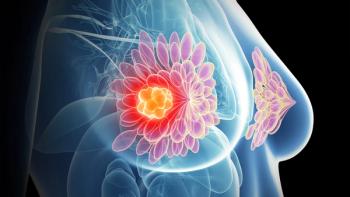
Temferon Is a Viable Treatment Option in Newly Diagnosed Glioblastoma
Preliminary findings from the phase 1/2a TEM-GBM study highlight the potential utility of temferon, genetically modified Tie2-expressing monocytes targeting interferon a2 in treating patients with glioblastoma.
Temferon, genetically modified Tie2-expressing monocytes (TEMs) targeting interferon a2 (IFNa2), showed the potential to activate the immune system and reprogram the tumor microenvironment in patients with newly diagnosed glioblastoma (GBM), according to preliminary findings from the phase 1/2a TEM-GBM study (NCT03866109)
“These results provide the initial evidence for on-target activity of Temferon in GBM,” said Bernhard Gentner, MD, study coauthor and the leader of the translational stem cell and leukemia research unit at San Raffaele Telethon Institute for Gene Therapy in Milan, Italy, in a presentation of the findings at the 2022 AACR Annual Meeting.
Temferon is an investigational advanced therapy consisting of autologous CD34+ enriched hematopoietic stem and progenitor cells exposed to transduction with a lentiviral vector, driving myeloid-specific IFNa2 expression. Genetically modified TEMs target IFNa2 expression in the GBM tumor microenvironment.
“In order to guarantee stable delivery of genetically engineered TEMs into the tumor, we transduce hematopoietic stem and progenitor cells with a lentiviral vector carrying the IFNa2 transgene transcriptionally regulated by the Tie2 promoter and by post transcriptional elements that guarantee that the transgene is expressed only in myeloid cells that are recruited into the tumor,” Gentner said.
TEM-GBM is an open-label, dose-escalation study evaluating the safety and efficacy of Temferon in up to 21 newly diagnosed patients with GBM harboring an unmethylated MGMT promoter. Following surgical resection, up to 15 patients were assigned to 1 of 3 escalating doses of Temferon and 1 of 2 different conditioning regimens in part A of the trial. In Part B, 6 more patients will receive a single dose of Temferon at the recommended phase 2 dose.
Following completion of radiotherapy, patients received a conditioning regimen consisting of carmustine (BCNU) and thiotepa (Tepadina) in cohorts 1 to 4 or busulfan (Busulfex) and thiotepa in cohort 5 prior to administration of Temferon.
In-patient monitoring occurs until hematological recovery, then patients will undergo regular follow-up for up to 720 days. At that point, patients are invited to participate in a long term follow-up study for an additional 6 years.
Eligible adults aged 18 to 70 years must have an ECOG performance score of 0 to 1, a Karnofsky performance score greater than 70%, and adequate cardiac, renal, hepatic, and pulmonary function. Patients with active autoimmune disease or who have received any oral or parenteral chemotherapy or immunotherapy within 2 years of screening are excluded.
The primary end points of the study are Temferon engraftment over the first 90 days, proportion of patients achieving hematologic recovery 30 days after autologous stem cell transplantation, and short-term tolerability of Temferon as defined by stable blood counts, absence of cytopenias, absence of significant organ toxicities greater than grade 2, and absence of Replication Competent Lentivirus.
By the October 15, 2021, data cutoff, the median follow-up was 267 days (range: 60-749). Patients in cohorts 1 to 3 received a dose 0.5-2.0 x 106/kg Temferon with an average vector copy number of 0.70 and a transduction efficiency of 54%. Those in cohorts 4 and 5 received 2.0 x 106/kg Temferon with an average vector copy number of 0.77 and a transduction efficiency of 49%.
Investigators observed increasing proportions of Temferon-derived differentiated cells, as determined by the presence of vector genomes in the DNA of peripheral blood and bone marrow cells, reaching up to 30% at 1 month in the highest treatment cohort (2.0 x 106/kg). Those differentiated cells persisted at lower levels for up to 18 months.
“All patients showed in vivo Temferon engraftment,” Gentner said. “Engraftment was highest at 1 month, and in many patients resembled pretty much the input fraction. …Engraftment then decreased, stabilizing at 3 to 6 months around 10%.
“Despite the significant proportion of engineered cells, only very low-medium concentrations of interferon alpha were detected in the plasma and in the cerebral spinal fluid, indicating a tight regulation of the vector expression.”
Gentner added that Temferon did not delay hemopoietic recovery, and neutrophil and platelet engraftment were similar to standard autologous stem cell procedure.
Investigators did not detect any dose limiting toxicities. Gentner said that, so far, adverse events have been related to progression or the transplant procedure, not to the IFNa2 itself.
Reference
Gentner B, Finocchiaro G, Farina F, et al. Genetically modified Tie-2 expressing monocytes target IFN-α2 to the glioblastoma tumor microenvironment (TME): Preliminary data from the TEM-GBM Phase 1/2a study. Presented at: 2022 AACR Annual Meeting; April 8-13, 2022; New Orleans, LA. Abstract 5213.
Newsletter
Knowledge is power. Don’t miss the most recent breakthroughs in cancer care.














































































